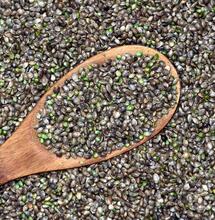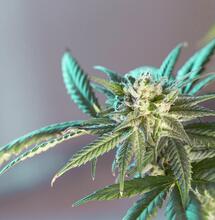The Eco-Friendly Harvest

Home-grown Cannabis from northern regions is often dominated by the indoor cultivator, but many are now switching to greenhouses.
Home-grown Cannabis from northern regions is often dominated by the indoor cultivator, but many are now switching to greenhouses.
A variable climate, especially in northern regions of North America and Europe, has resulted in a rapidly-growing army of indoor growers.
|
Frisian Dew produces strong plants with thick stems |
A quick glimpse of the sponsor advertisements in any international edition of Soft Secrets will show you just how large the market has become for the indoor cultivator. Nearly every major Western city now has thousands of home growers, and many of these cities have numerous grow shops to choose from. What's more, the number of indoor home-growers rises each and every year, a trend that has been in place since the 1980s. However, there are alternative ways - and more eco-friendly ways - to grow your own stash. After all, indoor growing consumes lots of electricity and the initial costs to buy your tent, light, carbon filter, fans, etc., comes at a price.
|
Greenhouse full of Frisian Dew, nearly ready for harvest |
Greenhouse growing is becoming more and more popular across the United States, Canada and especially Europe. Every year, we see lots of new growers achieve harvests beyond their wildest dreams, thanks to a small number of plants grown in greenhouses and poly-tunnels. There are no ongoing electricity costs to worry about, nor any electrical/fire safety concerns due to an unattended indoor grow-room while you are at work or on vacation. A single, well-grown Cannabis plant cultivated in a greenhouse can easily deliver over two pounds of top quality dried bud, even in Northern Europe.
Of course, not everyone is lucky enough to own a yard on which they can put a greenhouse. Even so, many growers who do own a greenhouse are discovering the joy of growing a plant or two within it. And those growers who have enjoyed success with greenhouses will tell you that pot grown under the sun, in soil, often has an extra 'kick' of potency and flavor. Some Cannabis varieties are selectively bred to be able to grow outdoors, without greenhouses, even in Northern European countries such as the UK, the Netherlands, etc.
Extremely good results can be achieved in such a climate with purely guerrilla-grown Cannabis. However, anyone who has been inside a warm greenhouse when the sun is shining in early spring or late autumn will tell you what a tremendous difference it makes to have a thin sheet of glass, polycarbonate or poly-tunnel over the plants. This effectively extends the growing season and enables the growers to amplify the harvest quantity they can achieve by protecting the plants from the worst of the weather.
|
Frisian Dew, blooming in the sunshine |
Perhaps the biggest concern for greenhouse growers is the security of their crop, but even that is starting to change. Greenhouses are now available in a massive range of sizes, from small, single-plant units that can be discreetly placed in the corner of a garden or patio, all the way up to the fantasy greenhouses, in which you can grow dozens of thirteen-feet-tall monster plants. Greenhouses can also be made from a variety of materials, from completely transparent glass to (the stoner-favorite) opaque polycarbonate, which ensures privacy for your crop. Poly-tunnels have long been a favorite Continental way of providing ideal growing conditions while preventing everyone from seeing what is growing inside. These days, greenhouses can be supplied, if preferred, with lockable doors to provide an extra sense of security - which also keeps the kids from accidentally discovering your favorite hobby.
|
There are plenty of buds on every bloom! |
Many greenhouse growers often tend to grow smaller numbers of plants than the indoor grower. The reason for that is simple enough: a well-grown greenhouse Cannabis plant can often yield more than several smaller indoor, tent-grown plants. This is an important legal consideration for the greenhouse grower, especially for those growing in countries where Cannabis remains illegal - the penalties for getting caught with one or two plants in a greenhouse are likely to be less severe than for an indoor grower with ten-plus plants in a tent.
Cannabis plants grown in greenhouses/poly-tunnels have unrestricted root growth, which can promote epic plant growth. The photographs shown in this article come from a legal Belgian Cannabis social club called TUP, who grew sixteen Dutch Passion Frisian Dew plants in a greenhouse. The Frisian Dew plants were thirteen feet tall and eleven feet wide; the average yield was two-and-a-half pounds of dried Cannabis per plant, with the heaviest one yielding almost seven pounds and the worst plant still respectably delivering just under two pounds. Many indoor hobby growers are happy to get 0.1 to 0.2 pounds (50-100 grams) per plant, so the attractions of greenhouse/poly-tunnel growing are obvious enough.
|
Greenhouse full of beautifully-grown Frisian Dew plants |
What follows are several important tips - from the best greenhouse growers - which will help you to get the heaviest crops.
Soil Quality
A little bit of effort to improve the soil quality will pay serious dividends to the end result. This will often mean hard work. The soil should be dug in order to aerate it. Manure, nutrients and other additives such as bat guano, worm castings, etc., can be added to ensure that the roots have a plentiful supply of minerals to absorb.
Air Flow
This is often the most underrated aspect of greenhouse growing. You can have some top quality Cannabis seeds, great soil and lots of sun, but if you do not have enough fresh air flowing through the plant, you will see final yields reduced. In the case of our legal TUP greenhouse, the airflow was difficult to maintain evenly throughout the 98.5-foot length of the greenhouse. The difference in yield between the side of the greenhouse with good airflow and the side with poorer airflow was 3.3 pounds.
|
Harvest time: Frisian Dew drying |
Sunlight
The more sunlight, the better; Cannabis plants can soak up nearly all of the light thrown at them. If you are planning to use a greenhouse or poly-tunnel, try to use the best location, one which gives all-day exposure to light.
Heat
Even in Northern Europe and the more northerly parts of North America, greenhouse temperatures can exceed 104º F (40º C) during mid-summer. This puts a lot of stress on the plant and will increase water requirements. Ensuring plenty of fresh air (eg. through roof windows/vents) is one way to help the plants through the extreme heat.
|
The beginning of the grow: sixteen small Frisian Dew plants getting started |
The results can be spectacular, even if conditions are not optimized. Take a look at the photographs from the TUP grow. The Frisian Dew plants grew to incredible proportions and provided pounds of top quality, totally organic Cannabis. For the self-sufficient home grower, just one good greenhouse plant could easily provide a year's-worth of recreational/medical Cannabis. In a greenhouse, the plants will often start to bloom around August in northern climates and finish in September or October. The extra protection that the greenhouse gives the plants at the end of the season helps the plants in coping with the onset of cool and damp conditions. If the plants look like they will out-grow the greenhouse, several options are available. Plants can be repeatedly topped during the early stages to produce shorter and bushier growth, or they can be tied down to prevent the main growing tip from crashing into the greenhouse roof.
|
Frisian Dew's rich covering of resin and beautiful colors |
Greenhouse/poly-tunnel growers fall into two categories - those who root the plants directly into the ground and those who grow plants in containers. Each method has its own advantages and disadvantages. Plants rooted directly into the ground cannot be moved if an emergency arises; on the other hand, they will not require daily watering in the summer and can be left unattended for days or weeks, if necessary. Greenhouse plants grown in containers can be moved, if circumstances require it, but just like monster tomato plants, they will need regular feeding and watering to survive.
The rapid increase in the number of home growers really has seen a surge in the number of indoor growers. However, for those growers with access to a greenhouse or poly-tunnel, there are great opportunities to grow all the pot you need from a small number of plants, at hardly any cost.



